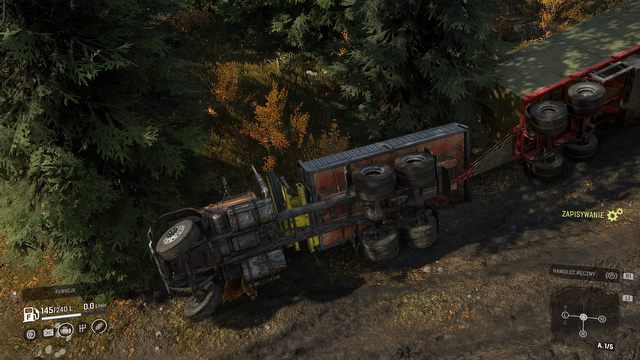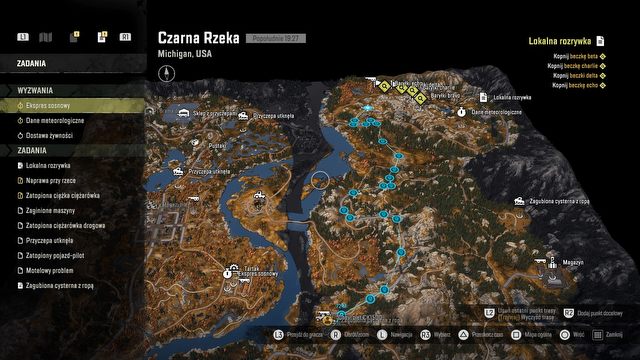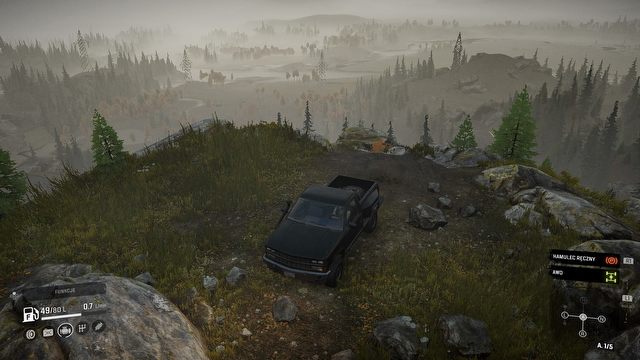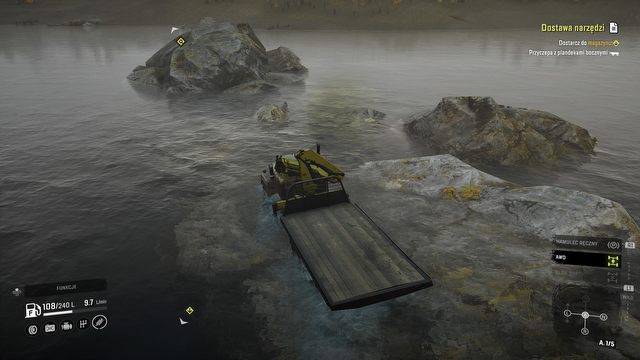Learn to drive. SnowRunner – Death Stranding with trucks

Learn to drive
Enter SnowRunner, all dressed in white, six months after the release of Death Stranding. Or actually, all dressed in muddy-brown: having spent the entire past week playing the game, I only caught a glimpse of snow – when I tried playing in Alaska to check if I was ready to face the severe weather of sub-arctic tundra. The game quickly showed my I'm still a noob and I ought to go somewhere sunnier.
Of course, driving trucks and delivering cargo is not a new concept in video games, as both Hard Truck and Euro Truck Simulator have been providing exactly that for years. Then, there's even more games that let us drive through mud and grave in all sorts of races. And then there are games like Motorstorm, which combined both concepts. In each of these games, the difficulty was not driving, but rather perfectly memorizing tracks and mastering vehicles, beating speed records and pushing lap times by milliseconds.
SnowRunner does with driving what Death Stranding did with walking. The ostensibly simple phenomenon of a mechanical vehicle moving forward is made exponentially more intricate with introduction of realistic factors determining speed, grip, and vector. The challenge is not only in reaching the destination in time, but also making sure the cargo is not damaged. Actually, forget time – reaching the destination at all is a heck of a feat. A larger hill or a muddy stretch of the road – normally, you wouldn't even take the foot off the gas pedal, but not here. Here, these become deadly, treacherous obstacles that can end your adventure if you don't have a winch and a clue how to properly operate the gearbox in these situations.
Fortunately, the game offers a tutorial that's extensive enough to accommodate even off-road newbies such as myself. That doesn't mean it was an easy accommodation. During the first hours I spend with SnowRunner, things were getting out of hand, and I was far beyond my comfort zone. Learning – often through painful mistakes – the dependencies governing this world that's completely alien to me, even though it offers an utterly faithful depiction of reality. Wasting half an hour because of one, stupid mistake. But there's also joy; unearthly joy of finally reaching the destination after an exhausting, outback excursion.
Just as in Kojima's work, the simple fetch quests are reinvented with intricate and novel mechanics, making me hanker for more even as I have already spent dozens of hours in the Saber Interactive's simulator. What's equally important, the game also makes sure you don't run out of new challenges.
Once we feel comfortable driving without roads, we're sent into waist-deep mud. Once the trucks are modified enough to easily cope with the mud, we're sent to hills so steep that no amount of torque seems enough. Once we overcome that, we get oversize trailers that completely demolish our notion of where it's possible to drive. Still doing this? "OK," says the game from over the desk, looking at you like a father looks at a child bragging about completing a puzzle. "Here's a map without a garage – you make a mistake, you lose all progress." Not to mention the snow, which – as already stated – is still beyond my capabilities after a week of intense play.
At the same time, the game also seems to adhere to the favorite principle of the entire IT world – "it's not stupid if it works." On numerous occasions, you can get out of trouble by using completely unconventional methods, and the game is completely ok with that. You can, for example, carry four pieces of cargo instead of two if you push the extra down with the crane at the back of the truck. You can drag trailers on a winch if you don't want to waste time switching cars. You can build a network of a few tankers to make refueling less of a hustle.
SnowRunner is very unforgiving – if you get stuck for good, you may lose 30 minutes of play or more. But it's ultimately worth it. Also because the game is very fair – failure is always caused by careless or reckless driving. If things don't go the right way, there's no one to point fingers at. But then, you usually know what the mistake was, and how to avoid it the next time. As long as you're into this type of gameplay, you might as well spend dozens of hours here, if not more.
FROM SPINTIRES TO SNOWRUNNER
The series has a rather interesting story. It all began with Kickstarter-funded Spintires, which debuted on PC back in 2014 through Oovee Games Studio and met a warm reception from gamers, and rather cool from reviewers (just 67% on Metacritic). The success warranted long-term development, but it wasn't all sunshine and bunnies for the studio all the time. In 2016, the game received an update that introduced many critical errors – rumor had it the game was sabotaged by one of the creators of the game, who felt cheated by the publisher. Spintires survived this difficult period and lives on to this day – the latest expansion to the game debuted at the end of 2019 and took us to Chernobyl.
In the meantime, Oovee Games Studio licensed the brand to Focus Home Interactive, who commissioned another studio, Saber Interactive, to develop MudRunner: a Spintires Game. That was essentially Spintires with quite a bit of additional content. The title debuted in October 2017, this time on PC as well as consoles. From this point on, MudRunner and Spintires were separate entities, with their own expansions and add-ons.
In case of SnowRunner, the situation is simpler – the game is a direct sequel to MudRunner and offers entirely new content compared to both predecessors.





